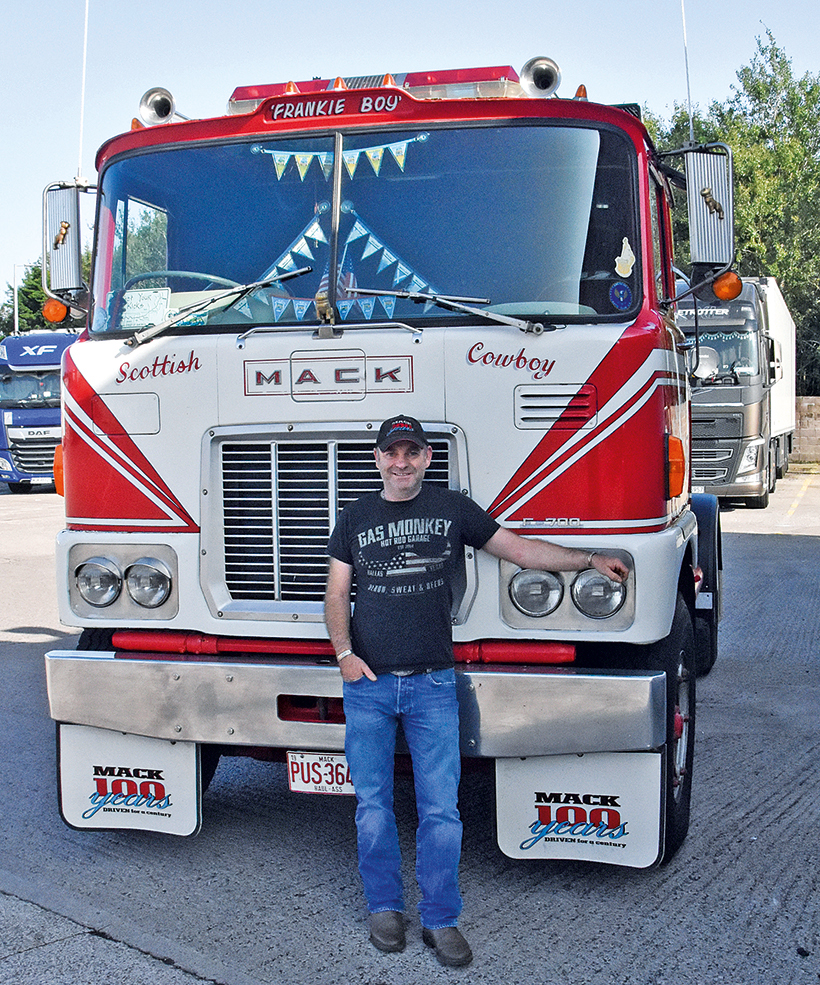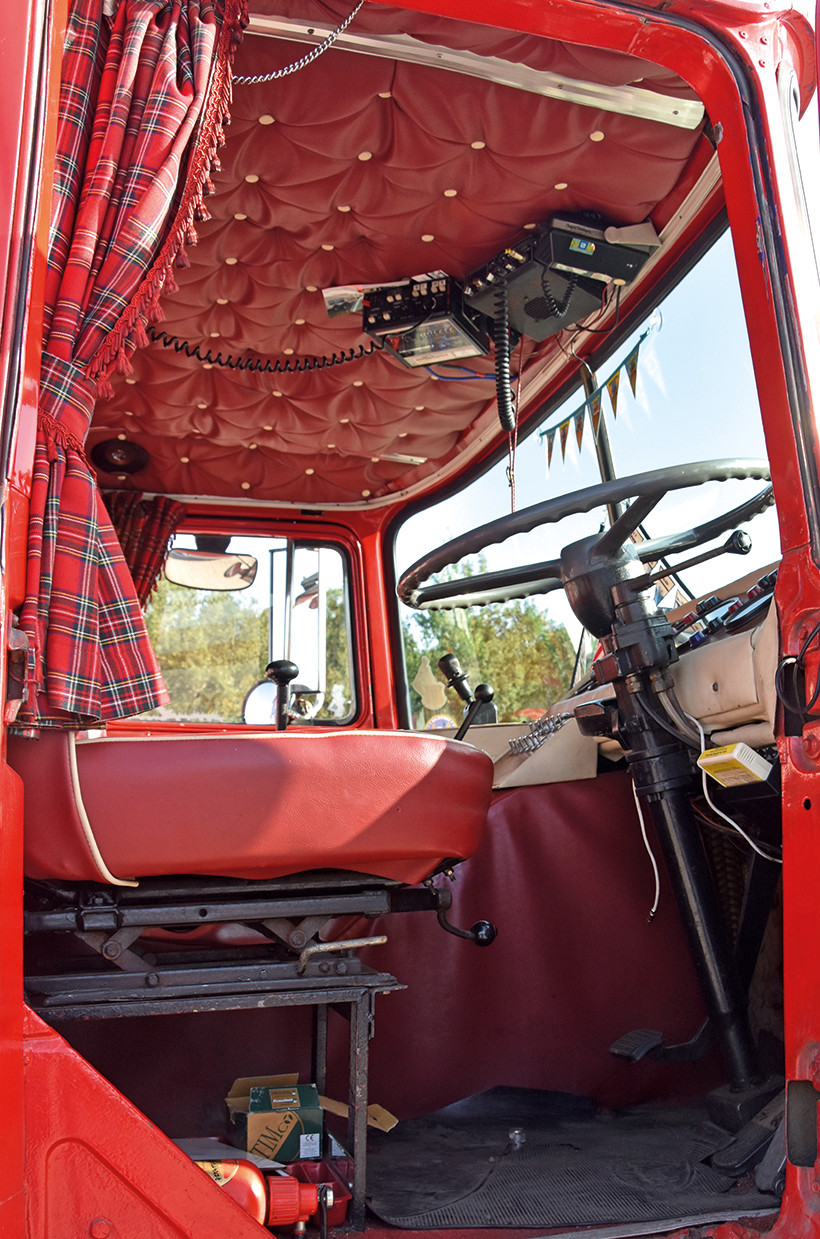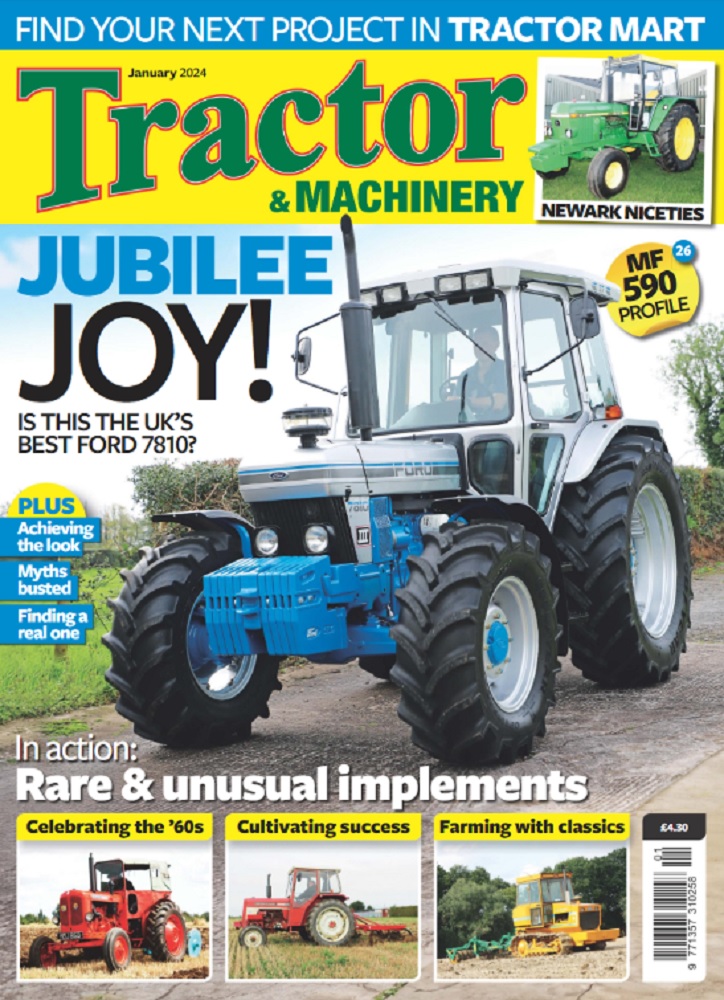1976 Mack F700-Series truck
Posted by Chris Graham on 16th June 2021
Bob Weir meets American truck enthusiast Frankie Wilson, from Scotland, and gets to grips with his impressive 1976 Mack F700-Series truck.

1976 Mack F700-Series truck: American lorries like the Mack are very popular with enthusiasts. Frankie Wilson has owned his 1976 F-Series since 2001, and the lorry is still his favourite.
Frankie developed an interest in American trucks from an early age, and still has a passion for the lorries. A driver by trade, he’s currently working with plant and equipment. “My father also worked in haulage and used to drive a Seddon diesel four-wheeler tipper,” he explained. “I followed in his footsteps, and passed my test when I was 21.
“I’m not a full-time driver at the moment, and spend most days working with a digger. I do have a job with a local haulage company – Graeme J. Wardrop – driving refrigerated Scanias long-distance, on alternate weekends. I take lorry loads of fish down to the market at Billingsgate, in London. It’s an overnight trip, and a good haul.”
The Mack is Frankie’s first classic lorry, and he’s owned the truck for 15 years. “Living next door to the M74 motorway while I was growing up was quite an experience,” he recalls. “Lorries were going past all the time, travelling between Scotland and England. Although I liked a lot of the European marques, I was also attracted to Mack trucks.
“I was very keen on the F700-series, and one lorry in particular. The truck had ‘Phantom 309’ painted on its cab, and really stood out from the crowd. Even though I was only 12 years old, I vowed I would own an American lorry one day.”

Frankie Wilson has been a big fan of American trucks since he was a lad.
The trucks Frankie spotted in the 1980s were owned by a company called West of Scotland Excavations. “The company was based in Scotland’s Central Belt, and used a lot of Mack lorries,” said Frankie, who is a member of American Trucks in the UK. “Seeing one of them on the road used to make my day. They were also showing the movie Convoy at the time, which was a very popular film.”
That film was made in 1978, and featured actor Kris Kristofferson and actress Ali MacGraw. It was released when the CB radio/trucking craze was at its peak in the United States, and was based on the 1975 Country & Western novelty song by CW McCall. The song tells the tale of Big Joe, who died at the wheel after steering his rig off the road to avoid a busload of children. Big Joe and the lorry assume a phantom existence, picking up hitchhikers who later feel a shiver down their spines when they’re told the ghostly tale of a truck going by the name of Phantom 309.
“I was a big fan of the movie, and it did a lot to promote interest in American lorries here in the UK,” said Frankie. “It’s great when you go to shows and trucks like the Mack come together from all over the country.” Frankie has always been keen on going to truck rallies, and visited Truckfest Peterborough in 2001.
“I met enthusiast John Smithhurst there, who’d brought along his Mack Cruiseliner,” he remembers. “We got chatting, and I mentioned that I was on the lookout for an American truck. John said that, apart from the Cruiseliner, he also had a couple of other Mack lorries that were available at a reasonable price. The only downside was that they both needed a makeover.

Although the F-Series cab was highly rated when the model was first introduced in 1961, it was starting to show its age by the mid-1970s
“Nevertheless, I drove down to his place in Nottingham the following weekend, to have a look. One of the lorries was the F700, and we quickly made a deal. I paid a deposit and arranged to have it delivered by Cadzow Heavy Haulage to Scotland, as part of a backload.”
Mack Trucks Inc. was founded in 1900, as the Mack Brothers Company. The new firm manufactured its first lorry in 1907, and adopted its current name in 1922. The firm was originally based in Brooklyn, New York, before moving to Allentown, Pennsylvania, in 1905. The company stayed there until 2009, then relocated to its current headquarters in Greensboro, North Carolina. Mack is now a subsidiary of AB Volvo.
Mack trucks are still built at the company’s plant in Lower Macungie, Pennsylvania, and, over the years, have been sold in more than 40 countries around the world. The engines are made at the factory in Hagerstown, Maryland. They also have additional assembly plants in Australia and Venezuela.

Frankie had to refurbish the lorry’s interior from scratch.
The Mack F series was the third generation of cabover trucks. Production started in 1962, and ran through to 1981. The lorry was built mainly as a set-forward axle truck, but a setback axle version was marketed overseas. The cab was available as a 50in (1,371.6mm) day cab, and sleeper versions included a 72in (1,828.8mm), 80in (2,032mm) and a ‘bustle back’, lengthening the sleeper to 86in (2,184.4mm).
Customers were offered five different diesel engines, ranging from in-house Maxidyne and Thermodyne units, to Cummins, Detroit Diesel and Caterpillar powerplants. The Cat3406 was a big-bore diesel and the Detroit Diesel 71, provided power with a high torque curve. The Cummins Formula 350 ‘Big Cam’ offered 1,065ft-lbs of torque, and the Cummins Formula 290 and NTC series of engines was also available. The lorry also featured taper-leaf front springs for a smoother ride, as well as optional power steering.
Frankie’s 1976 model F785RT is unusual in that it’s one of a number of RHD models converted in the Republic of Ireland, primarily for the UK market. A lot of the trucks were assembled at Saggart, near Dublin, for the Irish company, Mack Distributors Ireland Limited. Apart from the lorries destined for the UK, a number saw service in Ireland.

CB radio has always been associated with American lorries, and was an essential accessory back in the 1970s.
“Once the lorry had been delivered, I gave it a close inspection,” he recalls. “The inside of the cab was an empty tin shell, except for the driver’s seat. The door bottoms and rear quarter panels were in poor shape and needed some welding. I also trimmed-out the interior, including a new, buttoned headlining.”
Frankie remembers he had a particular problem getting hold of replacement seats. “An American supplier had quoted £600 each, which seemed a bit over-the-top,” he said. “So, I ended up buying a pair from a scrapyard for just a tenner. They had to be re-covered, but it seemed a lot better value.
“While I was about it, I swapped the fuel tank with a local enthusiast, from a square to round unit, and fitted a set of new wings. I also tidied-up a few other bits and pieces.” Frankie got a lot of spare parts from a Mack dealer over in the Netherlands. “I used to buy parts from Western Trucks, based down in Bolton, but the owner retired, and the company stopped trading,” he said. “Martien Monne trading as Mackmonne NL, in the Netherlands, bought all the stock, so I now use him instead.”

American dashboards were very different from those in contemporary, European lorries, and were well equipped.
Mechanically, the lorry was in a lot better condition. Fortunately, Frankie was brought up with tools, and so was able to do most of the work himself. Although he was working at the time, the job only took him the best part of six months. “The truck is equipped with the six-cylinder Maxidyne engine,” Frankie explained. “This can deliver 177kW (237hp) at 2,100rpm.”
This engine wasn’t the most powerful option in the Mack range, although the factory spec addition of a turbocharger certainly improved performance. The gearbox is a five-speed Mack unit with a splitter. This is applied by means of a three-position lever for high, low, and reverse, offering five speeds for each selection.
Having refurbished the lorry, Frankie also decided to treat the Mack to a fresh coat of paint. “I had a chat with Jimmy Campbell from West of Scotland about painting the F700 in its colour scheme, and he thought it was a good idea,” he said.

The Bulldog logo is an essential part of the Mack brand. The lorries earned the nickname during the First World War when, in 1917, the UK government bought the Mack AC to supply the troops. British soldiers dubbed the lorry the ‘Bulldog Mack.’
Since putting the Mack back on the road in 2001, the lorry has become a bit of a celebrity, and has even featured at sporting events. “There used to be an American football team called the Scottish Claymores, based in Glasgow,” he recalls. “They invited me along to the ground and photos were taken with the team’s cheerleaders. Other drivers also flash their headlamps when they see me coming, and I must admit I enjoy the attention!”
When Frankie first acquired the F700-Series, he didn’t know a lot about the Mack’s history. Fortunately, he was approached by a couple of enthusiasts on the 2004 Ulster Road Run, who were able to shed some light on the lorry’s past.
“The lorry was still wearing its original, Northern Ireland registration number, YZM 367,” he recalls. “They said the lorry was one of nine trucks converted to RHD in Ireland by a Hino dealership, and was originally new to Nestor’s Transport, in Galway.”

The fuel tank isn’t original, as Frankie didn’t like the square design used on some Mack trucks.
Frankie has owned a few trailers over the years and is currently looking for a new one. “The lorry can get a bit skittish when it’s not pulling a trailer,” he explained. “This is mostly due to the short, front spring travel. The driving position is quite high, and the clutch is mounted far back. The ride is a lot more assured when the lorry is hauling a trailer; it handles better with some weight on the axle. I tend to dodge drainage grids and potholes using the Mack’s power-assisted steering.”
Although owning the F-series had been an enjoyable experience, Frankie has also had a few issues with the lorry. “The engine blew up five years ago,” he recalls. “I was taking the lorry on a pre-rally season run around the local lanes, when the shaft in the oil pump sheared off. This did a lot of damage, and the repairs came to over £8,000. It took me long time to get hold of the right spares, and I had to hire someone to rebuild the engine.”
Frankie’s lorry was pressed into a sombre duty in the autumn of 2020, when it was used to transport the coffin of his best pal, Steven ‘Hutchy’ Burt, to the local crematorium.

The Mack has used a number of different trailers over the years. Frankie reckons that a decent load improves the lorry’s handling.
“Steven was also ‘truck daft’, and we did a lot of lorry-related things together,” he explained. “We used to go to Peterborough Truckfest most years, and always had a great time. One of his last wishes was that he could be taken to the crematorium on the back of the Mack.”
At the heart of Frankie’s passion for Mack lorries is a love of the USA; he’s been there on a couple of occasions. “I’m a big fan of Country & Western music,” he explained. “and also like going to American truck shows. I’ve been to the Grand Ole Opry in Nashville, and hope to go back in the foreseeable future.”
For a money-saving subscription to Heritage Commercials magazine, simply click here





